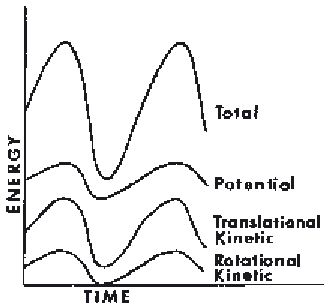Biomedical Engineering Reference
In-Depth Information
Figure 6.15
Energy patterns for a segment in which no exchanges are taking place.
All energy components are perfectly in phase.
Consider the other extreme, in which no energy exchange takes place. Such
a situation would be characterized by totally in-phase energy components, not
necessarily of equal magnitude, as depicted in Figure 6.15.
6.2.1.1 Approximate Formula for Energy Exchanges within a Segment.
An approximation of energy exchange can be calculated if we know the
peak-to-peak change in each of the energy components over a period of
time:
E
ex
=
E
p
+
E
kt
+
E
kr
−
E
s
(6.18)
If there is no exchange,
E
p
+
E
kt
+
E
kr
=
E
s
. If there is 100%
exchange,
E
s
=
0.
Example 6.4.
A visual scan of the energies of the leg segment during walk-
ing yields the following maximum and minimum energies on the stride period:
E
s
(
max
)
=
29
.
30 J,
E
s
(
min
)
=
13
.
14 J,
E
p
(
max
)
=
15
.
18 J,
E
p
(
min
)
=
13
.
02 J,
E
kt
(
max
)
=
13
.
63 J,
E
kt
(
min
)
=
0
.
09 J,
E
kr
(
max
)
=
0
.
95 J,
E
kr
(
min
)
=
0 J. Thus,
E
s
=
29
.
30
−
13
.
14
=
16
.
16 J,
E
p
=
15
.
18
−
13
.
02
=
2
.
16 J,
E
kt
=
13
.
63
−
0
.
09
=
13
.
54 J,
E
kr
=
0
.
95
−
0
=
0
.
95 J.
Since
E
p
+
=
0
.
49 J exchanged during the stride. Thus, the leg is a highly nonconservative
system.
E
kt
+
E
kr
=
16
.
65 J, it can be said that 16
.
65
−
16
.
16










Search WWH ::

Custom Search